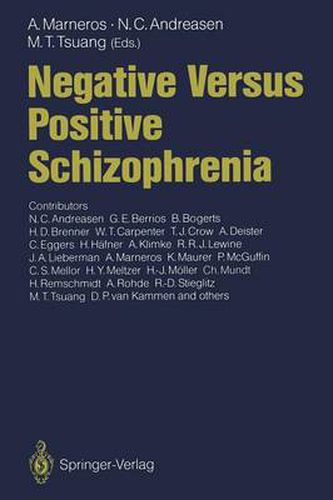Readings Newsletter
Become a Readings Member to make your shopping experience even easier.
Sign in or sign up for free!
You’re not far away from qualifying for FREE standard shipping within Australia
You’ve qualified for FREE standard shipping within Australia
The cart is loading…






This title is printed to order. This book may have been self-published. If so, we cannot guarantee the quality of the content. In the main most books will have gone through the editing process however some may not. We therefore suggest that you be aware of this before ordering this book. If in doubt check either the author or publisher’s details as we are unable to accept any returns unless they are faulty. Please contact us if you have any questions.
The positive versus negative distinction of schizophrenic disorders has pro- moted ongoing research. Phenomenology, psychopathology, biology, genet- ics, pharmacological and nonpharmacological treatment, psychosocial and longitudinal research: all have found a new focus of interest. This volume attempts to provide an unbiased picture of the status of American and Eu- ropean knowledge regarding the positive/negative distinction. Researchers from North America and Europe describe the relation of modern concepts of positive and negative symptomatology to the original models of Rey- nolds and Jackson. Integrating phenomenological, genetic, and biological factors, the authors depict current methods of assessing positive and nega- tive symptomatology, differentiating between primary and secondary symp- tomatology, and using pharmacological and nonpharmacological treatment. The stability of positive and negative symptoms over time and evidence for the occurrence of separate positive and negative episodes over a long-term course of schizophrenia are extensively discussed in terms of their implica- tions on the positive/negative construct. The relevance of the positive/nega- tive dichotomy to child and adolescent schizophrenia is also debated. The main aim of this book is not to advocate a single concept and present only arguments supporting it, but to discuss important controversies. Prob- lems concerning a concept cannot be solved by ignoring them. However, unanswered questions may be resolved through discussion, debate, and con- structive compromise.
$9.00 standard shipping within Australia
FREE standard shipping within Australia for orders over $100.00
Express & International shipping calculated at checkout
This title is printed to order. This book may have been self-published. If so, we cannot guarantee the quality of the content. In the main most books will have gone through the editing process however some may not. We therefore suggest that you be aware of this before ordering this book. If in doubt check either the author or publisher’s details as we are unable to accept any returns unless they are faulty. Please contact us if you have any questions.
The positive versus negative distinction of schizophrenic disorders has pro- moted ongoing research. Phenomenology, psychopathology, biology, genet- ics, pharmacological and nonpharmacological treatment, psychosocial and longitudinal research: all have found a new focus of interest. This volume attempts to provide an unbiased picture of the status of American and Eu- ropean knowledge regarding the positive/negative distinction. Researchers from North America and Europe describe the relation of modern concepts of positive and negative symptomatology to the original models of Rey- nolds and Jackson. Integrating phenomenological, genetic, and biological factors, the authors depict current methods of assessing positive and nega- tive symptomatology, differentiating between primary and secondary symp- tomatology, and using pharmacological and nonpharmacological treatment. The stability of positive and negative symptoms over time and evidence for the occurrence of separate positive and negative episodes over a long-term course of schizophrenia are extensively discussed in terms of their implica- tions on the positive/negative construct. The relevance of the positive/nega- tive dichotomy to child and adolescent schizophrenia is also debated. The main aim of this book is not to advocate a single concept and present only arguments supporting it, but to discuss important controversies. Prob- lems concerning a concept cannot be solved by ignoring them. However, unanswered questions may be resolved through discussion, debate, and con- structive compromise.